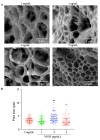Functionalized Collagen/Poly(ethylene glycol) Diacrylate Interpenetrating Network Hydrogel Enhances Beta Pancreatic Cell Sustenance
- PMID: 37367166
- PMCID: PMC10298015
- DOI: 10.3390/gels9060496
Functionalized Collagen/Poly(ethylene glycol) Diacrylate Interpenetrating Network Hydrogel Enhances Beta Pancreatic Cell Sustenance
Abstract
Three-dimensional matrices are a new strategy used to tackle type I diabetes, a chronic metabolic disease characterized by the destruction of beta pancreatic cells. Type I collagen is an abundant extracellular matrix (ECM), a component that has been used to support cell growth. However, pure collagen possesses some difficulties, including a low stiffness and strength and a high susceptibility to cell-mediated contraction. Therefore, we developed a collagen hydrogel with a poly (ethylene glycol) diacrylate (PEGDA) interpenetrating network (IPN), functionalized with vascular endothelial growth factor (VEGF) to mimic the pancreatic environment for the sustenance of beta pancreatic cells. We analyzed the physicochemical characteristics of the hydrogels and found that they were successfully synthesized. The mechanical behavior of the hydrogels improved with the addition of VEGF, and the swelling degree and the degradation were stable over time. In addition, it was found that 5 ng/mL VEGF-functionalized collagen/PEGDA IPN hydrogels sustained and enhanced the viability, proliferation, respiratory capacity, and functionality of beta pancreatic cells. Hence, this is a potential candidate for future preclinical evaluation, which may be favorable for diabetes treatment.
Keywords: beta pancreatic cells; biomaterial; collagen; hydrogel; interpenetrating network; vascular endothelial factor.
Conflict of interest statement
The authors declare no conflict of interest.
Figures







References
-
- Fowler M.J. Microvascular and Macrovascular Complications of Diabetes. Clin. Diabetes. 2008;26:6. doi: 10.2337/diaclin.26.2.77. - DOI
-
- SoRelle J.A., Naziruddi B. Beta Cell Replacement Therapy. In: Wagner D., editor. Type 1 Diabetes–Pathogenesis, Genetics and Immunotherapy. InTech; London, UK: 2011.
-
- de Vries R., Stell A., Mohammed S., Hermanns C., Martinez A.H., Jetten M., van Apeldoorn A. Transplantation, Bioengineering, and Regeneration of the Endocrine Pancreas. Elsevier; Amsterdam, The Netherlands: 2020. Bioengineering, Biomaterials, and β-Cell Replacement Therapy; pp. 461–486.
Grants and funding
LinkOut - more resources
Full Text Sources

